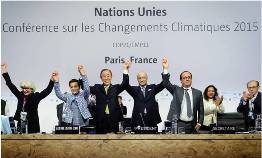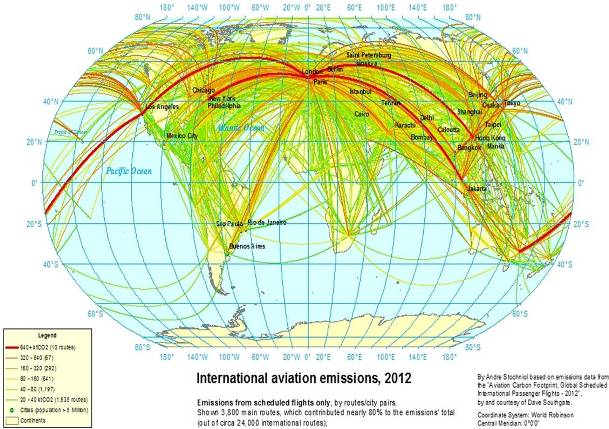- Home
- Case for Action
- IMFUND
- Solution - 3rd generation
- Buy-in
- AGF
- Achievements
- Awards
- Negotiations
- Bali 2007
- Bangkok 2009
- Barcelona 2009
- Bonn 2008
- Bonn 2009
- Bonn 2011
- Bonn 2013
- Brussels 2008
- Cancun 2010
- Copenhagen 2009
- Doha 2012
- Durban 2011
- Geneva 2009
- Lima 2014
- London 2008
- London 2009
- London 2010; 1
- London 2010; 2
- London 2011
- London 2012; 1
- London 2012; 2
- London 2013
- Montreal 2013
- Panama 2011
- Paris Goals 2016
- Poznan 2008
- In limbo ...
- Presentations
- Historical
- Search
- About
Aviation, Shipping and the Paris Agreement
 The Paris Agreement (PA) provides a new global framework to address climate change with a global goal to hold temperature increase below 2°C. It has been agreed by all 196 parties to the UNFCCC and represents a dramatic departure from the previous ineffective top-down regulatory regime which was applicable only to some countries. However, the PA does not cover international aviation and maritime transport even though emissions from both sectors are significant and projected to double or treble by 2050.
The Paris Agreement (PA) provides a new global framework to address climate change with a global goal to hold temperature increase below 2°C. It has been agreed by all 196 parties to the UNFCCC and represents a dramatic departure from the previous ineffective top-down regulatory regime which was applicable only to some countries. However, the PA does not cover international aviation and maritime transport even though emissions from both sectors are significant and projected to double or treble by 2050.
Outlook
PA’s compatible climate action in international aviation and shipping will depend now on agreements reached by governments within the ICAO and IMO, the two UN specialized agencies regulating these sectors. Six months after the PA, the signs are that an effective Market Based Measure (MBM), needed for these global sectors, may continue to evade each of them for years.A weak scheme, with many exemptions, to offset some of international aviation emissions above the 2020 level may be decided though by the triennial ICAO Assembly in Sept 2016. At the IMO, discussions on potential emission reduction or “fair contribution” of international shipping to the PA are yet to start.
A prospect for contributory climate finance decided by these two organizations seems faint now, given repeated decisions and statements against it by the ICAO, and suspension of relevant discussions in the IMO for three years. This could potentially change if finance ministers of major countries engaged on the issue, given that it stretches well beyond transport issues.
Case for action
Adequate climate action in these two sectors is important if PA climate mitigation, adaptation and finance goals are to be reached. Greenhouse gas (GHG) emissions from international aviation and shipping are significant and growing: if they either were counted as countries, they would each rank as top ten emitters. Emissions from both sectors are projected to double or even treble by 2050 (see ICAO technical analyses and Third IMO GHG study).In addition, both sectors enjoy tax-exempt fuel. National governments have a weaker claim on these tax bases than they do for domestic fuels, making them appealing as a possible source of climate finance. There are challenges, including the need for international coordination (especially important for maritime, given the mobility of the tax base) and legal issues (especially for aviation, due to treaties and bilateral air service agreements limiting fuel taxes). Nevertheless, the practicalities should be manageable (see IMF, After Paris, staff discussion note).
Recent developments
Negotiations to reduce GHG emissions from international aviation and maritime transport continue in the ICAO and IMO, respectively, albeit at slow pace. The historic significance of the Paris Agreement has been acknowledged at both organizations by member states. However, the recognition that the work on MBMs must be fully aligned and support the Paris Agreement, and a commitment of each country making a contribution to the best of its ability, may come simultaneously with concerns about the inappropriate economic burden on developing countries (see a Joint Statement of Argentina, Brazil, China, India, Panama, Russian Federation and Saudi Arabia on International Aviation and Climate Change, ICAO, HLM-MBM, 2016).Both international aviation and shipping are complex and inherently global (as illustrated for aviation). Both industries clearly prefer a global, uniform approach to reduce their emissions rather than a patchwork of regional regulations.
ICAO, international aviation
In 2010, ICAO Member States adopted global aspirational goals to improve the international aviation sector’s fuel efficiency by 2 per cent per year and maintain global CO2 emissions from 2020 at the same level (net after offsetting; so called carbon neutral growth from 2020, CNG 2020).To deliver the CNG2020, the sector needs emission offsetting/MBM. Emission reductions from the application of fuel-efficient technologies, operational and infrastructure improvements, and alternative fuels alone will not be sufficient to achieve the CNG2020, due to long life of aircraft and high growth of international aviation.
Subsequently, the 38th ICAO Assembly in 2013 agreed to develop a global MBM (GMBM) scheme for international aviation, although with some countries’ reservations. Significant efforts have been since made to develop a recommendation for a GMBM scheme capable of being implemented from 2020, in time for a decision at the 39th ICAO Assembly in Sept 2016. Initial progress was made by the ICAO Council’s Environment Advisory Group (EAG) with technical support provided by the ICAO Committee on Aviation Environmental Protection (CAEP). A High-level Group on GMBM Scheme was established to facilitate convergence of views, and Global Aviations Dialogues (GLADS) were conducted in five world regions. A draft Assembly Resolution on a GMBM scheme was then considered by the High-level meeting from 11 to 13 May 2016, to provide recommendations to the ICAO Council, in preparation for the 39th Assembly.
The current proposal for GMBM is a simple scheme to offset emissions above the 2020 level to deliver CNG2020, and is called the Carbon Offsetting Scheme for International Aviation (COSIA). It does not raise any revenue, and has various options for route-based exemptions and implementation phases put forward by governments, including at the recent High-level meeting. As reported by observers, divisions between governments over how to share the benefits and burdens of pollution cuts in the international aviation sector continue to threaten prospects for an agreement to limit these emissions. For instance, some options in the current draft would exempt half of aviation emissions from the scheme for several years. The target="_blank">differences on key points are summarized by the ICAO.
IMO, international maritime transport
At the IMO, the relevant work is carried out in the Marine Environment Protection Committee (MEPC). The MEPC has been considering actions to address greenhouse gas (GHG) emissions from ships engaged in international trade for over a decade. However, there is no agreement in MEPC on any target for GHG emission reductions yet, nor time for re-starting discussions on market based measures (MBMs). The recent focus has been on technical measures, as well as on technical co-operation and capacity building in relation to energy efficiency regulations.The mandatory energy efficiency (EE) requirements have now been in force for over three years. They apply to internationally trading ships of 400 gross tonnage (GT) and above, and make mandatory the: (1) EE Design Index (EEDI), and (2) Ship EE Management Plan (SEEMP) for all ships.
Before these EE measures came into force in 2013, many governments and the shipping industry were, in principle, opened to MBMs and climate finance, while some governments were opposed. Workable revenue raising MBMs were tabled and assessed, including how to reconcile various positions and address disproportionate impacts on certain countries. However, all discussions on MBMs were put on hold 3 years ago. Climate finance and possible use of MBM revenues were last discussed formally at MEPC 64 in 2012. In that session MEPC only agreed to discuss it further at the following session (including, discussion of follow-up submissions on the IMERS proposals, MEPC 64/5/10 and MEPC 64/5/12). At the following session, MEPC 65 in 2013, MBMs were essentially marginalized and the Committee decided to suspend their discussions to ... a future session (and deciding to focus on technical matters, including data collection on fuel consumption). Such "future session" has not happened yet.
At the recent MEPC 69, April 2016, a proposal for collecting fuel data in international shipping was approved. Amendments to MARPOL Annex VI that will require ships over 5,000 GT to record and report their fuel consumption could enter into force in 2018. The establishment of the IMO Ship Fuel Consumption Database is to be the first in a three-step approach in which analysis of the data annually collected (second step) would provide the basis for a policy debate in the MEPC (third step). This is to allow a decision to be made, on whether any further measures are needed to enhance energy efficiency and reduce greenhouse gas emissions from international shipping.
At the same time, a discussion at the recent MEPC 69 on a possible emission reduction target for international shipping in line with the Paris Agreement’s “well below two degrees” global warming, as well as future work to further reduce GHG emissions, led only to an agreement to discuss them further. A working group will be held at MEPC 70 for an in-depth debate on the reduction of GHG emissions from ships. For further details see the IMO press release, IMO submission to the UNFCCC, as well as a reporting summary, reporting summary, and critical views from an NGOand an observer.
UNFCCC – Climate finance through international aviation and maritime transport
Regarding climate finance in aviation and shipping, the prospects for any agreement over the next few years seem lower than before.While the Paris Agreement and associated COP21 decision did not include reference to international aviation and maritime transport, one of the key elements in the Agreement is that developed country Parties should continue to take the lead in mobilizing climate finance from a wide variety of sources, instruments and channels, with a concrete roadmap to achieve the goal of jointly providing USD 100 billion annually by 2020 for mitigation and adaptation through 2025. The Conference of the Parties serving as the meeting of the Parties to the Paris Agreement (CMA) is to set a new financial goal prior to 2025 from a floor of USD 100 billion per year (Paris Agreement, Article 9, and associated COP21 Decision, paragraphs 53 and 114).
In this context, the 2016 submission from ICAO secretariat to the UNFCCC reiterated objections to international aviation as a potential source for climate finance:
A group of countries reiterated this objection recently as well (in paragraph 17).
This dynamic in climate finance could potentially change if finance ministers of major countries (G7/G20) recognized the reasons for, and potential of, raising contributory climate finance through charges or carbon pricing of international aviation and maritime transport (such sources have been recommended by numerous experts, including by the IMF, World Bank to the G20 finance in a report Mobilizing Climate Finance).

